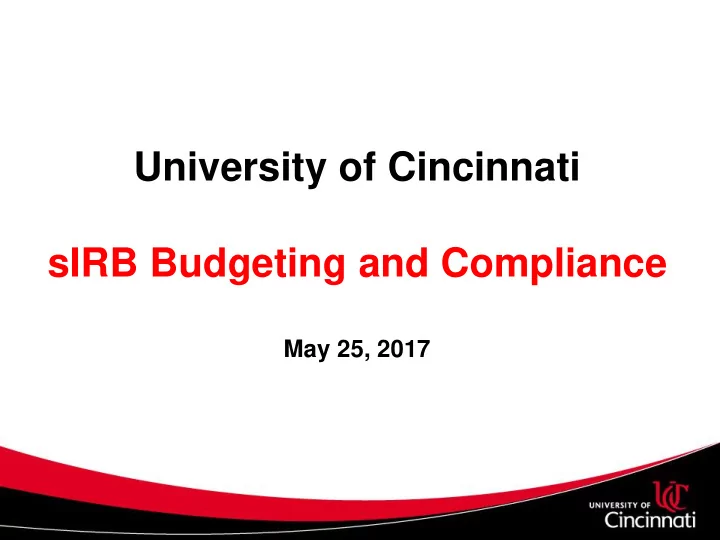

University of Cincinnati sIRB Budgeting and Compliance May 25, 2017
About Me • Director, Government Cost Compliance, University of Cincinnati • My office oversees and audits activities for approximately 40 service centers across UC • Negotiate F&A and fringe benefit rates with DHHS on behalf of university, and determine proper classification of direct and indirect costs for rate calculations
Defining Costs • Direct costs are those which can be allocated to a specific project and are included in the project budget. • Indirect costs are those which are incurred in service to sponsored projects, but cannot be allocated to a particular project. – These are recovered via F&A rate – University IRB is paid for as an indirect cost • CONSISTENCY is key to costs – like costs must be treated in like manner for all projects
Treating sIRB costs as Direct • NIH allows certain sIRB costs to be charged as direct, even if normal IRB activity is treated as indirect • Only “Secondary Activities” are allowable as direct – PRIMARY ACTIVITIES “refer to the activities associated with conducting the ethical review of the proposed research protocol that will be carried out at all of the participating sites and the review of the template informed consent document describing the study.” – SECONDARY ACTIVITIES “refer to the activities associated with the review of site -specific considerations for all of the participating sites, including investigator qualifications, institutional capabilities, state/local regulatory requirements, and community ethos. Following initial approval, there are additional activities associated with fulfilling IRB oversight responsibilities, including the reviewing reportable events from all participating sites, e.g., unanticipated problems, protocol deviations, and, as necessary, reporting them to the Office for Human Research Protections (OHRP) and the funding Institute or Center as appropriate; receiving and reviewing any complaints that arise with regard to the conduct of the study; notifying all participating sites of serious or continuing non-compliance and all other determinations; and communicating with participating sites on matters related to sIRB determinations.”
Treating sIRB costs as Direct • Simplified Version: If we have always provided the service for everyone requiring IRB review, and/or we provide it for ordinary projects requiring IRB, we cannot direct charge for it. Otherwise, we can.
4 Methods for Budgeting • METHOD 1: Use of a Commercial IRB for Secondary Activities – PRO: Simplicity – expenses are clearly defined; least administrative burden – PRO: Can be used in concert with other methods; can be used on some projects and not on others, per desire of PI/administration – CON: University may not wish to engage commercial IRB for various reasons
4 Methods for Budgeting • METHOD 2: Direct charge time/effort of IRB personnel and other costs to project budget – PRO: Ensures recovery of all secondary activity costs – PRO: Assigns secondary activity costs accurately to each project – CON: Can be time-consuming and paperwork-intense. Many personnel actions will be required, increasing admin burden. Budget justification may be more complex.
4 Methods for Budgeting • METHOD 3: Establish a “service center” for sIRB activity – A service center (or specialized service facility) is able to charge a service rate (hourly, daily, per use, etc.) to sponsored projects – PRO: Ensures recovery of all secondary activity costs, with fewer and simpler admin actions than direct charging individual costs – PRO: Easier for PI to budget – CON: Establishing a service center takes time, creates additional management burden for IRB (rate reviews, etc.)
4 Methods for Budgeting • METHOD 4: Remove all IRB costs from F&A pool, and charge ALL projects for IRB activity using one of first 3 methods – PRO: Recover all costs for IRB activity – due to F&A caps/negotiations, indirect costs are only partially recovered – PRO: Eliminates need to differentiate between primary and secondary activities – CON: Would require new direct expenses for every project that uses IRB, cutting into available budgets and potentially angering Pis. Increased admin burden for all IRB-related projects
Recommend
More recommend